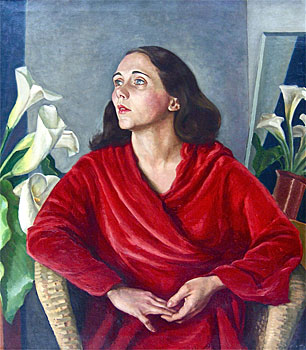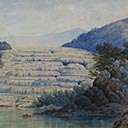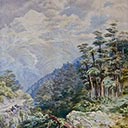Portrait Of Annette Stiver
83 x 72.5 cm
est. $25,000 - 35,000
Illustrated: p. 17 Art in New Zealand, September 1931
English artist Christopher Perkins spent the years 1929 to 1932 teaching at Wellington's Technical College Art School. At the same time Mr Michael Stiver, a New York advertising executive, had come to the city to establish an office for J.Walter Thompson. This was the first international advertising agency to set up a New Zealand operation, Stiver being responsible for the General Motors account in this country. Perkins painted this portrait of Annette Stiver, formerly known as Portrait of Mrs Michael Stiver, in 1931. In terms of painterly upward sweeping rhythm he seems to have taken his cue from the subject's distinctively retroussé nose. The profusion of arum lilies that surrounds her is mysterious. Usually regarded as a symbol of purity here they may offer a clue to the notion that the sitter and his subject were close. This painting was exhibited at the seventh annual exhibition of the Contemporary Group at the Macquarie Gallery, Sydney in November 1932. Mr and Mrs Stiver had earlier moved to Sydney after car sales in New Zealand plummeted during the Depression. In 1967 the painting was reported to be in the subject's own collection in New York. It was sold at auction in New Zealand in 1986.
PETER SHAW
Christopher Perkins was born in England and studied at the Slade School of Art, London. During his period of study he visited Italy where he studied the work of the great Renaissance masters. He served in field artillery and camouflage units during World War I following which he settled first in East Anglia then at the French Mediterranean port of St Tropez. Here he devoted his attention to still life compositions as a means of perfecting his control of tone. Two years later he decided to concentrate on landscape paintings and moved to Sanary, Provence near Aix to be near the country made famous in Cezanne's landscapes. It is said that on first reaching Aix, Perkins removed his shoes and walked barefoot straight to Cezanne's house.
Returning to England, Perkins applied under the La Trobe Scheme for a job as an instructor at the Wellington Technical College Art School, arriving in New Zealand in March 1929 when he was disappointed at finding a transplanted piece of Victorian England rather than the Gauguinesque South Seas landscape he had imagined. He was disappointed too to find that Maori art was for the most part concealed in museums and little appreciated by the Europeans. His aim was the creation of a national art based upon popular appreciation. Like H. Linley Richardson he was also to paint pictures of Maori subjects and motifs. Perkins was to advocate a search for local subject matter and express a conviction that there was a particular clarity of light in New Zealand.
In Art in New Zealand of June 1934 the writer and critic A.R.D. Fairburn was to give these views about the painter's task in New Zealand their most authoritative expression: "There is no golden mist in the air, no Merlin in our woods, no soft warm colour to breed a school of painters from the stock of Turner, Crome, Cotman and Wilson Steer. Hard clear light reveals the bones, the sheer form of hills, trees, stones and scrub. We must draw rather than paint, even if we are using a brush, or we shall not be perfectly truthful ".
These controversial notions have been repeated or subjected to critical scrutiny ever since, most notably by Francis Pound in an essay called The Land, The Light and Nationalist Myth in NZ Art in Te Whenua, Te Iwi; The Land and The People. ed. Jock Phillips. Allen and Unwin/ Port Nicholson Press 1987 pp 48-60. Defeated by local painters' reliance on English models and alienated because of his own fearless criticisms of the New Zealand art scene, Perkins was unable to achieve his desired aims here. By 1933 he had returned to England.





